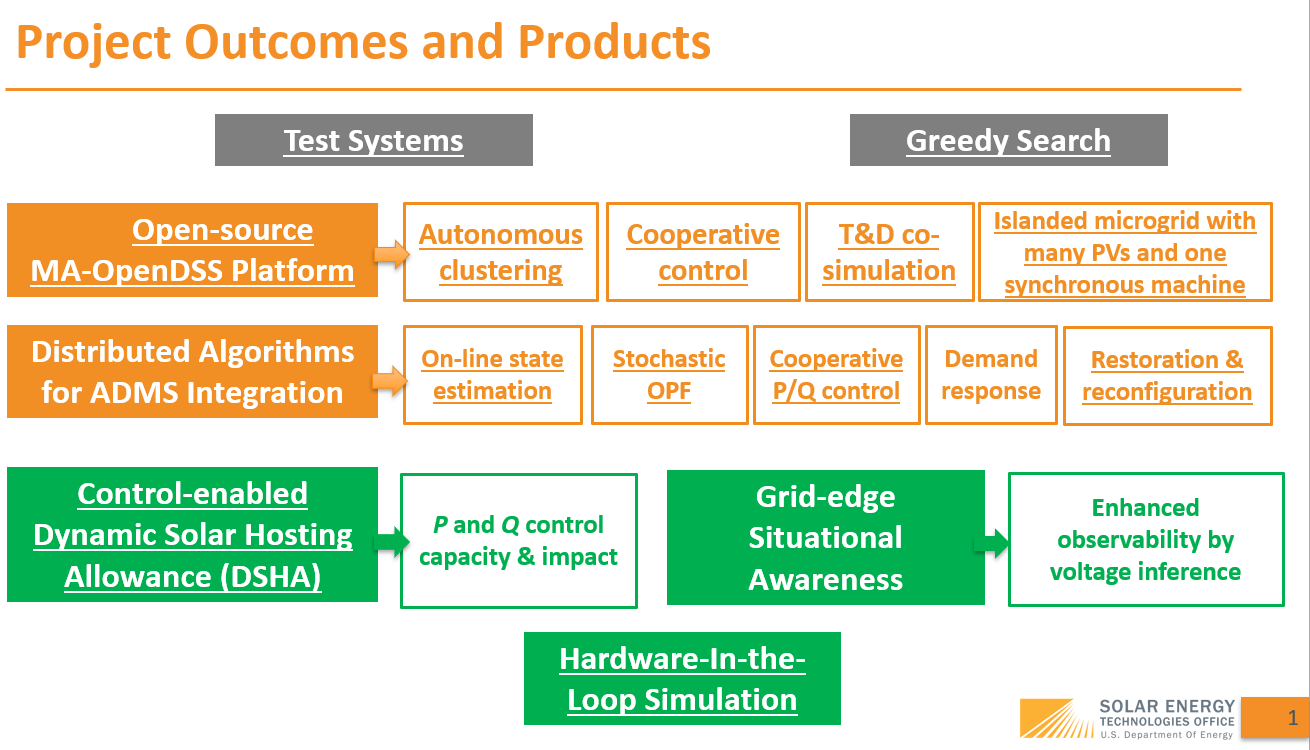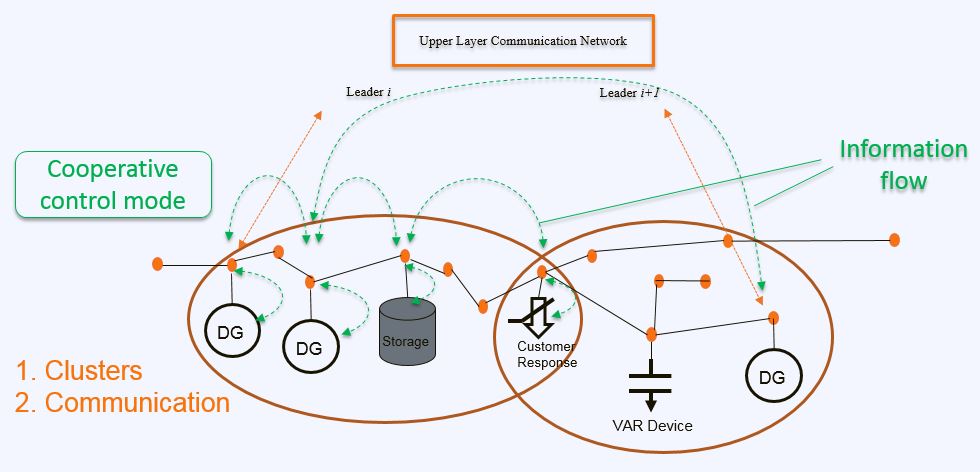Multi-Agent OpenDSS Platform
Overview
The Open-source Distribution System Simulator, OpenDSS, is a comprehensive electrical power system simulation package for electric utility power distribution systems. It has two modes: sinusoidal steady-state simulation, and time series (or quasi steady-state) simulation. Both are very efficient and useful for many analyses. Built upon OpenDSS is a Multi-Agent OpenDSS, MA-OpenDSS. The MA-OpenDSS incorporates an asynchronous, local, possibly varying communication architecture, enables a set of virtual nodes (called virtual leaders) to coordinate local data sharing and actions, includes programmable dynamic blocks for behaviors of distributed energy resources, and implements a host of distributed and cooperative algorithms of estimation, optimization and control. It is specifically developed to simulate and investigate self-organizing microgrids and large-scale electricity distribution networks with extremely high renewable penetrations.
Project Outcome and Products
Description of Version 3.1 (released 1/30/2021)
The MA-OpenDSS platform consists of three major components, 1) the modeling & simulation engine is based on the OpenDSS with the added functions including, generic distributed energy resource (DER) model to implement distributed control strategy, solver improvement to include distributed control, distributed communication modeling, and data processing and visualization; 2) the multiagent system architecture includes a hierarchical and distributed communication and control architecture, shown in Figure 2 and combined with the OpenFMB standard to enable the lower level communication between intelligent entities and nodes, and the upper level communication between intelligent devices and central system operator; and 3) the solution algorithms include distributed estimation, control and optimization, which enable advanced functionality at both the device and local levels and integrate them into the system level in a fully modular manner and with enhanced system-level solutions. These innovations build up a modular, plug-and-play, and scalable platform for real-time operation and control of large-scale distribution networks with high DER penetrations.
The MA-OpenDSS platform also enables the development of advanced distribution management system functions, including 1) an online multi-level distributed stochastic optimal power flow (OPF) based on a reverse-forward engineering procedure and dynamic, real-time, distributed feedback control for three-phase unbalanced distribution system; 2) an online distributed system state estimation (SE) algorithm based on prediction-correction methods for time-varying convex optimization, and with the joint real-time SE-OPF solver to calculate OPF based on the estimated voltage for more practical implementation; 3) the distributed Volt/VAR optimization and frequency control algorithms to optimally dispatch the real and reactive power of multiple DERs based on distributed cooperative control and optimization, with the robust performance against communication delays; 4) the distributed distribution system restoration strategy to optimally determine the PV generation, network configuration, switching status, and load pickup, in order to restore the entire system or energize unfaulted out-of-service areas, as well as to coordinate the restorative actions between transmission and distribution networks; and 5) the distributed PV hosting capacities with cooperative Volt/VAR and Volt/VAR/Watt control to provide recommendations for customers and the utility company.
Moreover, the advanced functions are tested in 1 million (1M)-node distribution system on the MA-OpenDSS platform. The 1M-node distribution system has been designed by combining ten 100k-node test systems from two larger fully synthetic test systems from NREL and San Francisco Bay Area. Furthermore, a two-stage greedy search algorithm is developed to find a realistic worst-case scenario for 100% PV penetration, considering both the location and the size of the PVs in the primary and secondary nodes of a feeder, in order to validate the effectiveness of the developed distributed functionalities.
The MA-OpenDSS is an effective, open-source tool to conduct simulations of DERs and their controls, distribution and/or transmission networks. It has been available and used in several settings: 1) Enhanced OpenDSS-G (OpenDSS Graphical User Interface) which includes MA-OpenDSS functionalities allowing the user to visualize and interact more directly with the distribution network and all its elements without needing to code; 2) Simulation of distribution network with large-scale and/or small-scale PV/DERs; 3) Co-simulation of transmission and distribution network with high-penetration DERs; 4) Hardware-in-the-loop (HIL) and power hardware-in-the-loop (PHIL) simulations; and 5) Integration with other open-source tools (such as OpenFMB and Helics) as well as commercial software (such as ADMS and/or DERMS) for real-time implementation. To the best of our knowledge, MA-OpenDSS is the first and only platform that can be used as a planning tool to systematically perform control-enable hosting capacity analysis. When used as a real-time control and optimization tool, it can eliminate or substantially reduce curtailment through effective reactive and active power controls. These features enable and support extremely high penetration of PVs.
Downloadable of 1M-Node System and Final MA-OpenDSS Package

Earlier Releases and Functionalities
Added Features of Version 2.1 (released 9/15/2019)
- 100% penetration across distribution networks, including secondary sides of service transformers
- Distribution network restoration centralized solution
- Distributed AC Optimal Power Flow
- Distributed State Estimation
- Hardware-In-The-Loop Tests using Opal-RT
Added Features of Version 1.3 (released 3/15/2019)
- Islanded operation of distribution networks
- Cooperative control of DERs with communication delays
- Test results of an 100,000-node system with scenarios of small-scale and large-scale DGs
Added Features of Version 1.2 (released 9/15/2018)
- Optimal clustering algorithm
- Cooperative control of active power among distributed energy resources
- Test results of an 11,000-node system under variable operational conditions and topologies
Added Features of Version 1.1 (released on 3/15/2018)
- Virtual leaders and their local communication architecture based on OpenFMB
- Automated process to undertake penetration impact studies, both large-scale PV sites and roof-top PVs, at 100% penetration or higher
- Distributed optimization and control algorithms for voltage stability
- Test results of IEEE 123-bus system under variable operational conditions and topologies.
Features of Version 1.0 (released on 12/15/2017)
- Asynchronous and local communication architecture
- Generic dynamic model of distributed energy resources
- Monte Carlo simulation of PV penetration up to 100%

Earlier Downloadable
64-Bit MA-OpenDSS (version 2.1):
- Complete Package with Manual and Executables (UCF)
- Distribution Network Restoration – Centralized Solution for IEEE 8500 (UCF)
- Multi-Phase Distributed OPF and State Estimation (NREL)
- Hardware-in-the-loop Testing (UCF)
64-Bit MA-OpenDSS (version 1.3):
64-Bit MA-OpenDSS (version 1.2):
High-Penetration Impact Study – Greedy search algorithm (version 1.2):
64-Bit MA-OpenDSS (version 1.1):
High-Penetration Impact Study – Greedy search algorithm (version 1.1):
Acknowledgements
- The earlier development of distributed optimization and cooperative control algorithms is supported under US National Science Foundation under grant ECCS-1308928.
- The OpenDSS is an open-source electric power Distribution System Simulator (DSS) developed by Roger C. Dugan at EPRI.
- The development of Multi-Agent OpenDSS (MA-OpenDSS) is supported in part by US Department of Energy’s awards DE-EE0007998, DE-EE0007327 and DE-EE0006340.
- The OpenFMB is a standard proposed by Duke Energy.
- The development of MA-OpenDSS is assisted by Roger Dugan (EPRI) and George Gurlaskie (Duke Energy). Its functionality is outlined in the 2021 IEEE smart grid newsletter article Multi-Agent OpenDSS, An Open Source and Scalable Distribution Grid Platform – IEEE Smart Grid
- The development and test are done in Siemens Digital Grid Laboratory which is generously supported by Siemens Digital Grid North America.